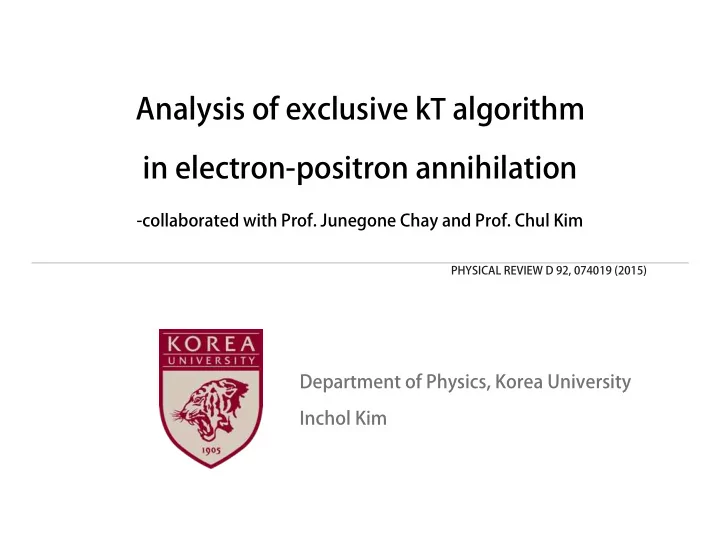

Analysis of exclusive k T algorithm in electron-positron annihilation -collaborated with Prof. Junegone Chay and Prof. Chul Kim Department of Physics, Korea University Inchol Kim PHYSICAL REVIEW D 92, 074019 (2015)
Contents -Physical Review D 92 034012 (2015) 1. Factorization formula for the cross section 2. Exclusive kt algorithm 3. Generalized kt algorithm 4. Conclusions 2/19 Korea University Inchol Kim
Factorization formula for the cross section • We have factorized dijet cross section as following. • The jet and soft function is defined as 3/19 Korea University Inchol Kim
Exclusive kt algorithm - The definition single jet. 1. For each pair of partons i and j, work out the distance 2. If is smaller than , merge two partons into a 3. Repeat from step 1 until no particles are left. 4/19 Korea University Inchol Kim
Exclusive kt algorithm - Momentum assignments mass squared is given by • We assign the momentum flow as • Then the energies of two partons and the invariant- 5/19 Korea University Inchol Kim
Exclusive kt algorithm - Constraint functions function. • With the previous variables, we get the jet constraint 6/19 Korea University Inchol Kim
Exclusive kt algorithm - Constraint functions as follows. • Similarly, one can derive the soft constraint function 7/19 Korea University Inchol Kim
Exclusive kt algorithm - Virtual contributions 1 the scattering cross section is independent of the algorithm. Virtual contributions are independent of algorithms • The virtual contribution to the one loop correction of 8/19 Korea University Inchol Kim
Exclusive kt algorithm - Virtual contributions 2 UV and IR divergences. • The results for the virtual contributions are as follows. • We used dimensional regularization to regulate both 9/19 Korea University Inchol Kim
Exclusive kt algorithm - Real gluon emissions have problematic integral. • In the calculation with the exclusive kt algorithm, we 10/19 Korea University Inchol Kim
Generalized kt algorithm - The definition single jet. 1. For each pair of partons i and j, work out the distance 2. If is smaller than , merge two partons into a 3. Repeat from step 1 until no particles are left. 11/19 Korea University Inchol Kim
Generalized kt algorithm - Constraint functions function. • With the previous variables, we get the jet constraint 12/19 Korea University Inchol Kim
Generalized kt algorithm - Constraint functions as follows. • Similarly, one can derive the soft constraint function 13/19 Korea University Inchol Kim
Generalized kt algorithm - Constraint functions as follows. • Similarly, one can derive the soft constraint function 14/19 Korea University Inchol Kim
Generalized kt algorithm - Real gluon emissions 1 the previous integral. • With the generalized jet algorithm, we can calculate 15/19 Korea University Inchol Kim
Generalized kt algorithm - Real gluon emissions 2 • case is IR divergent. 16/19 Korea University Inchol Kim
Generalized kt algorithm - Real gluon emissions 3 • The soft contribution has similar features. 17/19 Korea University Inchol Kim
cannot be regularized by dimensional regularization. algorithm as a limiting behavior of the generalized kt algorithm. 2, but, for a , each factorized parts has IR divergence. breaks down. Conclusions • With the exclusive jet algorithm, there is an integral which • We can investigate the divergence structure of the kt • We have IR finite jet and soft functions for is smaller than • Since the IR divergence remains for , the factorization 18/19 Korea University Inchol Kim
resummation in deep-inelastic scattering, J. High Energy Phys. 01 (2007) 076. SCET, Phys. Rev. D 80, 114021 (2009). jet algorithms in SCET, J. High Energy Phys. 11 (2010) 101. positron annihilation with jet algorithms, Phys. Rev. D 92, 034012 (2015). References 1. T. Becher, M. Neubert, and B. D. Pecjak, Factorization and momentum-space 2. W. M. Y. Cheung, M. Luke, and S. Zuberi, Phase space and jet definitions in 3. G. P. Salam, Towards jetography, Eur. Phys. J. C 67, 637 (2010). 4. S. D. Ellis, C. K. Vermilion, J. R. Walsh, A. Hornig, and C. Lee, Jet shapes and 5. J. Chay, C. Kim, and I. Kim, Factorization of the dijet cross section in electron- 19/19 Korea University Inchol Kim
Recommend
More recommend